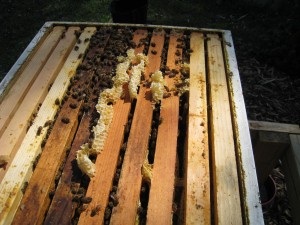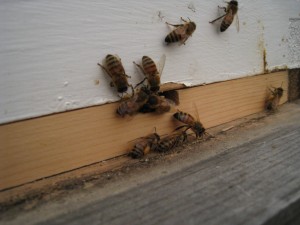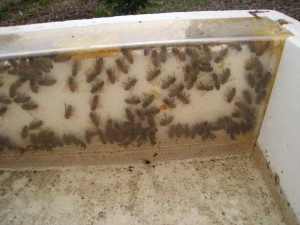I received the call from Tom that the Nuc’s were ready and picked them up last night, moving two to my apiary at home and taking one to Pop (Alex and I gave him one for Christmas.) Today was a busy day, looking at hives and squaring away the new Nuc’s, so let’s get to the records.
Charles City Hive (Pop’s Hive)
One of three Nuc’s received from Tom, we placed it under a Walnut tree near Pop’s garden, right up to one of the cow pastures. I advised him that the chance of getting shocked every time you looked at the Bee’s made this an inappropriate spot. He mumbled some words that I cannot relay on this site, basically calling to question my intelligence. Heh. We’ll see….
This Nuc was weaker then the one that I picked up from Tom last year. The bees were basically on 2-and-a-half frames. I couldn’t do a full inspection, as Pop started to freak out thinking that I was messing with them too much. Oddly, one actually stung me (Pop said he would have stung me too). I don’t wear my gear, gloves or veils when working Nuc’s and, up until this day, have never been stung. It wasn’t a big deal, but Pop thought it was funny. I was sorry that one bee killed herself to get me, as the Nuc didn’t have a bunch of bees to begin with. Once we get back from the beach (for Memorial Day), I might drop a frame of brood/nurse bees and a frame of honey from one of my hives into this Nuc.
We put the top feeder on them and Pop decided he would go without an entrance reducer.
Albo Hive
It is pretty clear to me that I will not get honey this year off of the Albo hive. The top deep has 7.5 frames drawn out, all but one full of honey and most of it capped. The one exception was a frame that had one side with a round patch of capped brood towards the bottom of the side. Since I found eggs and larvae in the bottom deep, I am guessing that the old Lady came up top to lay a few eggs when things were tight (full of eggs, larvae, pupae) below. Now that those bees have hatched, She is apparently working that area again (down below).
The honey super was just touched a tad, a bit of wax on two frames drawn out. Not much of a difference from the last inspection. Given this progress (or lack-thereof), I might split this hive in a week or two. The real question is ‘what does June hold?’ If I listen to the common word, the flow winds down over the next 4 weeks and it seems unlikely that the bees can draw out a full Illinois super and fill it with honey. I’ll have to think on it. I have 5 hives now. Do I want to increase this year?
Blue Cottage Hive (new Nuc)
This is one of the Nuc’s that I picked up last night. It is definitely the weakest Nuc that I have heard of. I almost wonder if Tom made a mistake. One frame of brood and one-and-a-half frames of pollen/nectar. This frame is actually so weak that I initially thought they had absconded when I was setting up, as not a bee came or left in about 30 seconds while I was preparing to do the investigation. Although I found capped brood and eggs, I did not see the queen (this absolutely shocked me, as there really were very few bees in this box.)
I put the entrance reducer on this one (and I might follow up with a robber screen). It would not take much to ‘do this hive in’. I also put the top feeder on and put a little syrup in (I doubt they can eat much, as there are not many to eat!) This pretty much confirmed my thoughts about moving some brood/nurse bees and a frame of honey to the Nuc’s to help them along. This will probably be the task for next weekend.
Westover Hive
The queen in this hive is a laying fool. To recap, they had been sucking down syrup over the past few weeks and I expected to find a lot of capped honey. Instead, I found about 7 fully drawn frames in the top Deep and all but one had brood in one stage or another (although mostly it was capped brood.) This was good, but it had me concerned that maybe the queen had moved up and wasn’t moving down. But, once I got to the bottom deep, I did find larvae in earlier stages then what was up top.
These bees have really exploded as far as population is concerned. I put on a honey super, just to give them room, but they are another candidate for splitting. It really depends on what June is going to hold for me. This hive is the ‘meanest’ of my hives. They always get antsy and send out a few bombers. I was very gentle with them this time and they still had a few that would have loved to stung me. These are my hottest bees, but they are also my hardest working bees. I will not get rid of this queen while this is the situation. I am thinking that letting them raise their own queen gives me the opportunity to get the hard working gene (that they have) with a more gentle gene (that my other hives have.) We’ll see.
Since I have only 3 top feeders (and have not made an inverted jar feeder yet), I only had two at home, having given one to Pop for his Nuc. So, I removed the top feeder from this hive to give it to my other Nuc’s. Once I decide whether to get more top feeders or use inverted jars, I might feed them some more (the top deep is not really fully drawn out yet.)
Geronimo Hive
As always, this hive had so many bees that it was impossible to find the queen. Several frames were two and three bees deep. They were literally crawling on one another. No sign of swarm cells and the honey super was hardly touched, so I am feeling good about this one. I will probably wait two more weeks to see if there is any chance of getting honey this year. If the outlook remains bleak, I will use this hive to fortify my weaker Nuc (the Blue Cottage Hive.)
Berkeley Hive (new Nuc)
I placed this new Nuc next to the Westover Hive (well, about 5 feet from it, but on the same foundation), so I called it the ‘Berkeley Hive’, after the plantation on the James that is just up from Westover Plantation is Charles City County. Of the three Nuc’s that I picked up from Tom, this one fit the bill as being a strong Nuc. There were 2-and-a-half frames of brood/bees and one-and-a-half frames of capped honey, nectar and pollen. Lot’s more bees here and what I sort of expected in the other Nuc’s. In fact, an orientation flight was taking place during the inspection which had me concerned (for a second) that the Westover Hive was on a raid. This Nuc is probably going to do very well. I did not find the queen, but really didn’t look hard (I was tired from looking at the other hives!), but did find eggs.
I put on the entrance reducer and also the feeder, giving them a good dose of syrup. Some of the bees from the Westover Hive were still in the feeding section, but I am hopeful that they will just join the current workforce.
Fortification (create a Nuc or not?)
As mentioned above, it is clear to me that I am going to need to fortify my Pop’s Nuc and the Blue Cottage Nuc. They are very weak. Starting a Nuc in late May is rough. Starting a weak one in late May seems like a one-way road to failure. So, I want to put one frame of honey and one frame of brood (with Nurse bees) in both of these hives. The problem boils down to my existing queens. I still have not developed the skill to be able to consistently find my queens. So, if I grab a frame of capped brood, I might accidentally grab my daggone queen! The queen is normally working the frames where she is laying eggs, but I can guarantee you that my queen will be hanging out on the capped brood frame.
So, how to deal with that? The first option is to take a lot of time and actually find the queen in the donor hive. I only do a spot check (maybe 30 seconds), but I have seen where some folks take 10 minutes. I am not a big fan of that option. The second option is to actually create another Nuc. If I take two frames of honey, two frames of capped brood and one frame of eggs and drop them into a Nuc, something is going to happen. Either queen cells show up in the Nuc (that’s what I would expect) or queen cells show up in the donor hive (whoops! I took my queen by accident and moved her to the Nuc!) In either case, I should be able to fortify the two existing Nuc’s without worrying about ‘fortifying with a wayward queen’.
At any rate, I have the weekend to think about this down at Nags Head.
Final Thoughts on the Hives (too much time!)
The full inspections that I did today took entirely too long. Working three established hives takes more time then I have (not to mention the coming baby, which is going to suck up even more time next year!) So, I need to develop a new plan. The first stage will be to break the hives out into two groups, so that I do an inspection every week, on one group or the other. The second step will be to reduce the number of hives that I fully break down during a given inspection. I am going to have to build an app for this blog that will schedule these things out so that I can track them accurately. More to think about….



